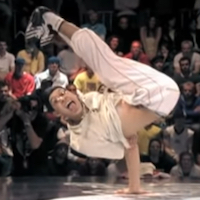Facial expression, the look on one's face, sometimes conveying a particular emotion.
History
One's facial expression has always been an aspect of breaking. Sasa mentioned using specific facial expressions while dancing in the early 1970s , while in the mid-1970s, according to the Almighty KG,

The scowl, or an otherwise hardened expression, is particularly common in breaking, and hip hop generally. An early description of Afrika Bambaataa read, "in his many snapshots from the period, Bambaataa looks young, lean, and angry, his eyebrows fused in a permanent scowl of disapproval—just the sort of look designed to intimidate whitey" . The scowl may have been a result of the environment in which breaking was created—Sean "Puffy" Combs asserted in 1994, "in street life you're not allowed to show if you care about something, you've got to keep that straight face" . Schloss theorized that "this basic survival mechanism has become abstracted as part of the b-boy dance," reflecting the ideal "that one should be intense yet totally in control [...] They should not only be prepared to battle at any time, but they should look it" . Vernon observed that "it is of prime importance to appear untroubled either by the difficulty of one's moves, the prowess of one's opponent in battle, or the unique pressures of the ritual environment" .
By 2005, sets could be seen punctuated with what Chang labeled a "Bruce Lee grin or a mocking Maori tongue" . Another well-known facial expression is Ken Swift's "mad mugsy," characterized by a puffed-out lower lip. Fabel claimed that Ken drew inspiration from Bruce Lee , while the name references the eponymous Looney Tunes character. It might be added parenthetically that "the first mugsy Character that Doze ever made was drawn from Ken Swift's Mugsy B-boy pose" .
There are differing opinions on making eye contact with an opponent. Ken recalled that there was not a lot of eye contact in the late 1970s, as it was considered disrespectful, but noted that
Dodds has pointed out that facial expressions can do more than simply express something, while at other times a particular facial expression is not one's conscious decision. Noting that dancers of different traditions (e.g. locking, house, krump) use certain expressions with different frequencies, Dodds suggested that "the face performatively demonstrates embodied knowledge of and cultural affiliation with the historical foundations of each [dance]," though without precluding "new meaning within the social and temporal space of each individualized battle" . Furthermore, recognizing that faces "are socialized according to racial and gendered norms," Dodds held that "faces are potentially read according to such norms [...] however, dancers possess the choreographic imagination to contend and resist these deeply socialized modes of facial expression" .
Footnotes
- Edited for clarity.
